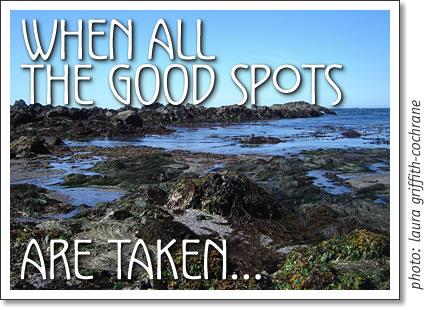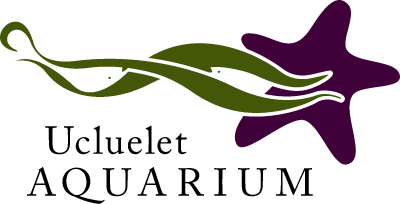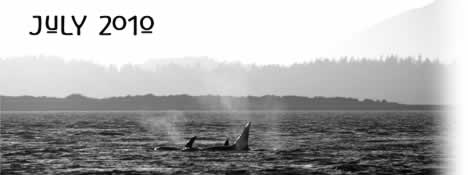
The Intertidal zone: when all the good spots are taken...
by Laura Griffith-Cochrane, Ucluelet Aquarium
![]() July is a hard time to find housing. With the arrival of summer, the coast fills with visitors, seasonal workers, honeymooners and hitchhikers. Good luck finding a room to rent. If you're stuck though, why not consider the intertidal zone?
July is a hard time to find housing. With the arrival of summer, the coast fills with visitors, seasonal workers, honeymooners and hitchhikers. Good luck finding a room to rent. If you're stuck though, why not consider the intertidal zone?
The west coast intertidal is a variable and rich habitat. Local upwelling from deeper water brings a fresh supply of nutrients to the coast. The colder water also carries more oxygen and thus larger body plans are possible here.
Unfortunately, intertidal zones can also be one of the most violent locations that you could possibly hope to live in. The moving tides bring a crashing force capable of pummeling anything into the rocks. Low tides expose organisms to hot sun, freshwater and air, which can dehydrate, drown or expose animals to predators. To live in this environment, animals must therefore have a way of surviving through these changes. They must have a way of maintaining their position in their chosen spot. They must have a way protecting their bodies from the drying air and sun, the toxic freshwater during rain and from land-based predators. They must have an efficient way of finding food since eating times are limited, and, like all other things, they'll need a way of finding a bit of love.
First, in order to survive in the intertidal zone, you'll need a method of staying there. There's a variety of ways. Long lines of bull kelp anchor one end and float the other. Their roots are called hold-fasts, which clasp around rocks and into crevices while their nitrogen-filled air sacs float the plant throughout the water column.
Barnacles glue themselves in place, and build casings around their bodies. Mussels extend long byssal threads from their core, these yellowish brown strings are 5 times as tough and 16 times as extensible as human tendons. This elastic, shock-absorbing capability means that the waves will neither break the anchors nor rip them as the water sucks back into the sea. Limpets, black turban snails, periwinkles, chitons, whelks and sea slugs all use their muscular feet in conjunction with powerful glues to hold them in place. Since they can move, they also cluster into holes and crevices.
In a similar way, the best place to view ochre stars is on the underside of ledges or in the more protected zones of the rocky beach, where the crashing force of the wave is broken up by the structure of the rock. When the tide is low, the hard bodies of these creatures either close (in the case of barnacles and mussels) or suck down onto the rocks to preserve the moisture within.
Feeding time. Creatures living around these fluctuating food sources must maximize their feeding efforts during incoming and high tides. Some animals, such as tunicates, mussels, porcelain crabs, and tube worms, have basket structures or fine filters to remove plankton from the waves. Barnacles can be seen feeding this way when waters return to the shore; they extend long figure-like projections covered in overlapping hairs which capture plankton. Anemones use sticky cells called colloblasts which attach to passing food items. These are concentrated on their long tentacles. Once small fish or invertebrates are caught, the anemone collapses in on itself, enveloping the tentacles and the caught prey whereupon it digests its victims in the stalk of its body. Many of the molluscs, such as the turban snails and chitons, simply slide along the rocks licking off algae with their sandpaper-like tongue (called a radula). The sea stars move along and surround the mussels and barnacles in this zone. By extending their stomach, they ingest their prey from the outside. Small fish such as gunnels and clingfish (which hide during low tide), move out to snap up small crustaceans and larval fish. The clingfish have strong modified fins to suck onto rocks while the waves surge around them.
Once you've claimed your place, and you've found a way of feeding yourself regularly, you'll probably be looking for that little bit of extra in your life. So, in turbulent waters, how do you find a mate? Sea slugs, and many other molluscs, have solved this issue through hermaphrodism (having BOTH male & female sex organs); any other individual they happen to run into is a possible mate. Barnacles are also hermaphrodites; they however cannot move. So to solve this matter, they have a penis 17 times their body length, able to extend across distances and fertilize their neighbours. Sea stars release their eggs and sperm into the sea water. Called broadcast spawning, all individuals spawn at the same time, ensuring that their genes have a better chance of being passed on to the next generation. Male red rock crabs have a much more selfish version of dating. When the males find a female, they hold onto her, sometimes for up to 2 months until she molts. At this point her body is soft, which is the only time when mating is possible.
We at the aquarium wish you luck should you decide to move into this rocky zone. If you need some inspiration, or want to see many other ways organisms modify their habits for these dangerous living spaces, the aquarium is open from 10-6, every day.
Laura Griffith-Cochrane is the Assistant Curator at the Ucluelet Aquarium.

Tofino Nature & Wildlife Articles
- A Foggy Adventure May 2002
- A Whale‘s Tale Mar. 2003
- Black Bears in Tofino Oct. 2002
- Excursion to Flower Rock Apr. 2003
- Living Off the Land Jan. 2003
- Ocean Day: June 8th June 2002
- On Lone Cone Feb. 2003
- Orcas in Clayoquot Dec. 2002
- Sea Otters Sep. 2002
- Steller Sea Lions June 2002
- Stormwatching Jan. 2003
- Strawberry Island 2002 Mar. 2003
- Strawberry Island Scuttlebutt May 02 May 2002
- Strawberry Island Scuttlebutt Aug.02 Aug. 2002
- Strawberry Island Scuttlebutt Dec.02 Dec. 2002
- The Clear Black Sky Sep. 2002
- The Secret Life of Barnacles April 2011
- The Windbirds are Back! May 2002
- Wolves of Vargas Island Jan. 2003
Tofino Time Magazine July 2010
- Tofino in July 2010
- Tofino beaches: Chesterman Beach
- Tofino Bear Smart: Reduce your garbage
- Mongoose Studio in Tofino: Green screen Magic
- Ucluelet Aquarium: The Intertidal Zone
- Horoscope for July 2010
- Tofino events in July 2010
- Tofino concerts in July 2010
- July 2010: movies in Tofino
- Tofino tide chart for July 2010
- Tofino surf reports for July 2010
- Tofino yoga classes in July 2010
- Pacific Rim Summer Festival: July 1-15, 2010
- Ukee Days in Ucluelet: July 23-25, 2010
- Directory: Tofino Accommodations, Dining & Services
tofino | tofino time | activities | accommodation | events | directory
maps | travel | food | art & artists | photos | horoscope | tides
search | magazine | issues | articles | advertising | contact us
hosted in tofino by tofino.net & studio tofino
© 2002-2019 copyright Tofino Time Magazine in Tofino Canada
Ucluelet Aquarium article about the intertidal zone on the Pacific Rim of Vancouver Island. From Tofino Time Magazine July 2010.

quick links:
- tofino accomodations
- tofino calendar
- tofino surf report
- tofino horoscope
- march horoscope
- tofino map
- tofino fishing report
- tofino tides
- tofino weddings
tofino events:
- tofino concerts
- tofino events
- tofino movies
- tofino festivals
- tofino yoga classes
- tofino whale festival
tofino time magazine:
- tofino time march 2016
- tofino event listings march 2016
- tofino concerts in march 2016
- tofino movies in march 2016
- cox bay | wickaninnish beach
- chesterman beach
- tonquin beach
- tofino brewing co.
- tofino wedding guide
tofino accommodation:
- tofino cabin
- tofino camping
- bed & breakfasts in Tofino
- tofino hostels
- tofino motels
- tofino hotels
- tofino vacation rentals
- petfriendly accommodation
activities:
- tofino bike rentals
- tofino bear watching
- tofino bird watching
- tofino boat charters & cruises
- tofino fishing
- hot springs cove
- sea kayaking in tofino
- tofino storm watching
- tofino surfing
- tofino whale watching
- tofino yoga
shopping:
services:
- tofino yoga, spa & wellness
- tofino restaurants
- tofino internet cafes
- tofino travel & transportation
- tofino real estate
- tofino taxi services
- tofino wedding & events
